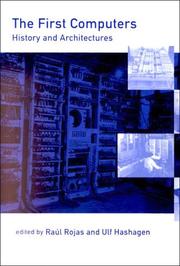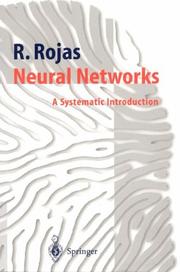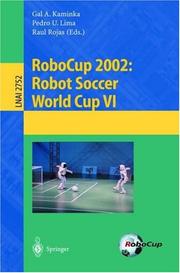| Listing 1 - 10 of 13 | << page >> |
Sort by
|
Book
ISBN: 3031398750 3031398769 Year: 2023 Publisher: Cham Springer
Abstract | Keywords | Export | Availability | Bookmark
 Loading...
Loading...Choose an application
- Reference Manager
- EndNote
- RefWorks (Direct export to RefWorks)
Digital
ISBN: 9783031398766 9783031398759 9783031398773 9783031398780 Year: 2023 Publisher: Cham Springer Nature, Imprint: Springer
Abstract | Keywords | Export | Availability | Bookmark
 Loading...
Loading...Choose an application
- Reference Manager
- EndNote
- RefWorks (Direct export to RefWorks)
Electronics --- Engineering sciences. Technology --- Computer architecture. Operating systems --- Computer. Automation --- History --- microprocessoren --- computers --- geschiedenis --- technologie --- hardware --- computergeschiedenis --- architectuur (informatica)

ISBN: 0262181975 Year: 2000 Publisher: Cambridge (Mass.) : MIT press,
Abstract | Keywords | Export | Availability | Bookmark
 Loading...
Loading...Choose an application
- Reference Manager
- EndNote
- RefWorks (Direct export to RefWorks)
Computer architecture --- Computers --- History. --- History.
Book
ISBN: 2586120082 Year: 1985 Publisher: Bogota Instituto Colombiano de Cultura
Abstract | Keywords | Export | Availability | Bookmark
 Loading...
Loading...Choose an application
- Reference Manager
- EndNote
- RefWorks (Direct export to RefWorks)

ISBN: 3540605053 9783540605058 3642610684 Year: 1996 Publisher: Berlin : Springer-Verlag,
Abstract | Keywords | Export | Availability | Bookmark
 Loading...
Loading...Choose an application
- Reference Manager
- EndNote
- RefWorks (Direct export to RefWorks)
Book
ISBN: 9783031398766 Year: 2023 Publisher: Cham Springer Nature Switzerland :Imprint: Springer
Abstract | Keywords | Export | Availability | Bookmark
 Loading...
Loading...Choose an application
- Reference Manager
- EndNote
- RefWorks (Direct export to RefWorks)
This book describes the historical development of the architectures of the first computers built by the German inventor Konrad Zuse in Berlin between 1936 and 1945. Zuse's machines are historically important because they anticipated many features of modern computers. Specifically, these include the separation of processor and memory, the ability to compute with floating-point numbers, a hardware architecture based on microprogramming of the instruction set, and a layered design with a high-level programming language on top. In fact, Zuse's early computers are closer to modern computers than the Harvard Mark I or ENIAC, two other contenders for the title of "world's first computer." The theoretical program first conceived by Zuse in 1936/37 was fulfilled with a series of machines built before and during World War II: the Z1, Z2, Z3, and Z4. Separate chapters deal with the architecture of each computer, culminating in the description of Plankalkül, the first proposal for a high-level programming language. Students of the sciences and practitioners of computer science should have no trouble following the material. The concise introductory summary sets the reader on the historical path to retrace this remarkable intellectual adventure. Raul Rojas is Professor of Mathematics and Statistics at the University of Nevada, Reno, US. He is also Professor Emeritus at Freie Universität Berlin. He has published two books on neural networks with Springer-Verlag, as well as the book “Die Rechenmaschinen von Konrad Zuse,”a volume that finds its continuation in this new book. Prof. Rojas was named Professor of the Year in Germany in 2014.
Computers --- Technology. --- History. --- Microprocessors. --- Computer architecture. --- Computers. --- History of Computing. --- History of Technology. --- Processor Architectures. --- Computer Hardware.

ISBN: 3540451358 3540406662 Year: 2003 Publisher: Berlin, Heidelberg : Springer Berlin Heidelberg : Imprint: Springer,
Abstract | Keywords | Export | Availability | Bookmark
 Loading...
Loading...Choose an application
- Reference Manager
- EndNote
- RefWorks (Direct export to RefWorks)
RoboCup 2002, the 6th Robot World Cup Soccer and Rescue Competitions and Conference, took place during June 19–25, 2002, at the Fukuoka Dome (main venue) in Fukuoka, Japan. It was, by far, the RoboCup event with the largestnumberofregisteredparticipants(1004persons,distributedin188teams from 29 countries) and visitors (around 120,000 persons). As was done in its previous editions since 1997, the event included several robotic competitions and aninternationalsymposium.Thepapersandposterspresentedatthesymposium constitutethemainpartofthisbook.Leaguereportsinthe?nalsectiondescribe signi?cant advances in each league and the results. The symposium organizers received 76 submissions, among which 17 papers (22%) were accepted for oral presentation at the symposium (?rst section of the book), and 21 papers (29%) were accepted as posters (second section of the book). Most papers were evaluated by three reviewers each, chosen from the members of the International Program Committee (IPC). The IPC consisted of a balanced combination of regular RoboCup participants and researchers from outside this community. The reviewers worked hard to guarantee a fair review process – the result of their work was a high-quality symposium with very - teresting presentations.
Robotics --- Artificial intelligence --- Robotics in sports --- Soccer --- Mechanical Engineering - General --- Mechanical Engineering --- Engineering & Applied Sciences --- Computer simulation --- Robotics. --- Artificial intelligence. --- Robotics in sports. --- Computer simulation. --- Association football --- English football --- European football --- Football (Soccer) --- AI (Artificial intelligence) --- Artificial thinking --- Electronic brains --- Intellectronics --- Intelligence, Artificial --- Intelligent machines --- Machine intelligence --- Thinking, Artificial --- Computer science. --- Science. --- Computer communication systems. --- Software engineering. --- User interfaces (Computer systems). --- Computer Science. --- Artificial Intelligence (incl. Robotics). --- Science, general. --- Computer Communication Networks. --- Software Engineering. --- User Interfaces and Human Computer Interaction. --- Simulation and Modeling. --- Football --- Sports --- Automation --- Machine theory --- Bionics --- Cognitive science --- Digital computer simulation --- Electronic data processing --- Logic machines --- Self-organizing systems --- Simulation methods --- Fifth generation computers --- Neural computers --- Artificial Intelligence. --- Science, Humanities and Social Sciences, multidisciplinary. --- Computer modeling --- Computer models --- Modeling, Computer --- Models, Computer --- Simulation, Computer --- Electromechanical analogies --- Mathematical models --- Model-integrated computing --- Informatics --- Science --- Computer software engineering --- Engineering --- Interfaces, User (Computer systems) --- Human-machine systems --- Human-computer interaction --- Communication systems, Computer --- Computer communication systems --- Data networks, Computer --- ECNs (Electronic communication networks) --- Electronic communication networks --- Networks, Computer --- Teleprocessing networks --- Data transmission systems --- Digital communications --- Electronic systems --- Information networks --- Telecommunication --- Cyberinfrastructure --- Network computers --- Distributed processing
Book
ISBN: 3319578138 331957812X Year: 2017 Publisher: Cham : Springer International Publishing : Imprint: Springer,
Abstract | Keywords | Export | Availability | Bookmark
 Loading...
Loading...Choose an application
- Reference Manager
- EndNote
- RefWorks (Direct export to RefWorks)
This book bridges the gap between Soft Computing techniques and their applications to complex engineering problems. In each chapter we endeavor to explain the basic ideas behind the proposed applications in an accessible format for readers who may not possess a background in some of the fields. Therefore, engineers or practitioners who are not familiar with Soft Computing methods will appreciate that the techniques discussed go beyond simple theoretical tools, since they have been adapted to solve significant problems that commonly arise in such areas. At the same time, the book will show members of the Soft Computing community how engineering problems are now being solved and handled with the help of intelligent approaches. Highlighting new applications and implementations of Soft Computing approaches in various engineering contexts, the book is divided into 12 chapters. Further, it has been structured so that each chapter can be read independently of the others.
Engineering. --- Artificial intelligence. --- Computational intelligence. --- Computational Intelligence. --- Artificial Intelligence (incl. Robotics). --- Soft computing. --- Intelligence, Computational --- Artificial intelligence --- Soft computing --- AI (Artificial intelligence) --- Artificial thinking --- Electronic brains --- Intellectronics --- Intelligence, Artificial --- Intelligent machines --- Machine intelligence --- Thinking, Artificial --- Bionics --- Cognitive science --- Digital computer simulation --- Electronic data processing --- Logic machines --- Machine theory --- Self-organizing systems --- Simulation methods --- Fifth generation computers --- Neural computers --- Construction --- Industrial arts --- Technology --- Cognitive computing --- Computational intelligence --- Artificial Intelligence.
Digital
ISBN: 9783319578132 Year: 2017 Publisher: Cham Springer International Publishing
Abstract | Keywords | Export | Availability | Bookmark
 Loading...
Loading...Choose an application
- Reference Manager
- EndNote
- RefWorks (Direct export to RefWorks)
This book bridges the gap between Soft Computing techniques and their applications to complex engineering problems. In each chapter we endeavor to explain the basic ideas behind the proposed applications in an accessible format for readers who may not possess a background in some of the fields. Therefore, engineers or practitioners who are not familiar with Soft Computing methods will appreciate that the techniques discussed go beyond simple theoretical tools, since they have been adapted to solve significant problems that commonly arise in such areas. At the same time, the book will show members of the Soft Computing community how engineering problems are now being solved and handled with the help of intelligent approaches. Highlighting new applications and implementations of Soft Computing approaches in various engineering contexts, the book is divided into 12 chapters. Further, it has been structured so that each chapter can be read independently of the others.
Book
Year: 2007 Publisher: Göttingen Cuvillier
Abstract | Keywords | Export | Availability | Bookmark
 Loading...
Loading...Choose an application
- Reference Manager
- EndNote
- RefWorks (Direct export to RefWorks)
In this paper, an active vision system is developed which is based on image strategy. The image based control structure uses the optical flow algorithm for motion detection of an object in a visual scene. Because the optical flow is very sensitive to changes in illumination or to the quality of the video, it was necessary to use median filtering and erosion and dilatation morphological operations for the decrease of erroneous blobs residing in individual frames. Since the image coordinates of the object are subjected to noise, the Kalman filtering technique is adopted for robust estimation. A fuzzy controller based on the fuzzy condensed algorithm allows real time work for each captured frame. Finally, the proposed active vision system has been simulated in the development/simulation environment Matlab/Simulink.
Artificial intelligence. Robotics. Simulation. Graphics --- robots --- computervisie
| Listing 1 - 10 of 13 | << page >> |
Sort by
|

 Search
Search Feedback
Feedback About UniCat
About UniCat  Help
Help News
News